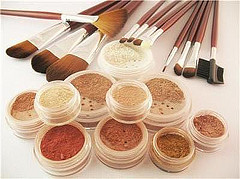 Have you jumped on the mineral makeup bandwagon? If so, you’re probably enjoying the benefits. Mineral makeup doesn’t clog or irritate pores, contains few (if any) preservatives or dyes, feels lightweight, and often includes ingredients that are good for the skin, like sunscreen (e.g., zinc oxide) and anti-inflammatories. However, they also contain very small particles that may pose some health risks.
Have you jumped on the mineral makeup bandwagon? If so, you’re probably enjoying the benefits. Mineral makeup doesn’t clog or irritate pores, contains few (if any) preservatives or dyes, feels lightweight, and often includes ingredients that are good for the skin, like sunscreen (e.g., zinc oxide) and anti-inflammatories. However, they also contain very small particles that may pose some health risks.
Remember when “antioxidants” seemed like a new, strange term? Well, now we have “nanoparticles”-a term on everyone’s lips in the cosmetic industry and in the science world. Basically, we’re talking about making things really, really tiny-like, you-can-see-them-only-with-a-very-powerful-microscope tiny. But for many applications, tiny is good. For example, British scientists are finding ways to use nanoparticles as tiny magnets that can heat up and kill cancer cells without harming healthy cells around them. Medicines coated in nanoparticles enable the drug to last longer in the body and reach its intended destination at lower doses. There’s even a skin patch that uses infection-fighting silver oxide nanoparticles to promote faster wound healing.
These nanoparticles, however, with seemingly unlimited potential in science, are causing some concern in the cosmetic industry. Why? Because you’ll find them in some lines of mineral makeup, where they could potentially cause damage to your health.
Just how big is a nanoparticle? The official definition is anything that is between 1-100 nanometers in diameter. How big is a nanometer? One-billionth of a meter, or as CTV News describes it: “Consider a human hair: its width is tens of thousands of times larger than a nanoparticle, as is the period at the end of this sentence.”
What is the makeup industry doing with nanoparticles? Using them in mineral makeup. Smaller particles produce that smooth, glow-like finish women like so much, and help the product feel light, fill in microscopic crevices, and glide easily over the skin. All great-unless you inhale it, or absorb anything toxic into your skin. (Teeny, tiny particles can more easily penetrate natural skin barriers and potentially infiltrate the circulatory system. Studies are currently underway to uncover any risks.)
Ultrafine particles, when inhaled, can become embedded in the lungs, where the body has a hard time removing them. So loose mineral makeup (powders) that contain nanoparticle ingredients can be a health risk, especially for those with allergies and asthma. However, our story doesn’t end there! A little bigger than the nanoparticle is what is known as the “micronized” particle. A micronized particle is measured in millionths of a meter (rather than billionths) and so is 1,000 times bigger than a nanoparticle, and considered by some to be less dangerous to the body. According to beautybythebatch.com, most mineral makeup companies claim to be using micronized ingredients (as opposed to nanoparticles), of 12-15 microns or higher (12,000-15,000 nanometers and up). The ETC Group (an action group on Erosion, Technology, and Concentration) says that a particle has to be 7 microns or smaller to penetrate the lungs or cell walls.
The bottom line? So far, with what we know today, you may want to avoid mineral makeup made with nanoparticles, and proceed with caution on those brands that use micronized particles. (Check out the Mineral Powder Foundation Ingredients List to identify which companies use them. Erth’s and Everyday Minerals state on their websites that they don’t use nano or micronized particles.) In addition, if you’re using loose mineral powder, Jenn Brockman (writing for Natural Beauty Examiner), recommends these tips:
- To reduce the chances of powder flying about in the air, work the powder into the brush (by swirling, tapping, buffing) so you don’t really see it anymore, and then apply to your face.
- Try using a flocked sponge-dip into your foundation, then swipe, dab, or rock across your face.
- Wetting the foundation down reduces the chance of airborn particles. Mix a drop or two of water or moisturizer with the foundation and apply with a foundation brush.
- You can also use a foundation brush with dry mineral makeup and reduce airborn powder.
What do you think of nanoparticles in makeup? Please share your opinion.
Photo courtesy Mineral Magic via Flickr.com.

